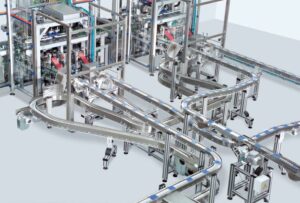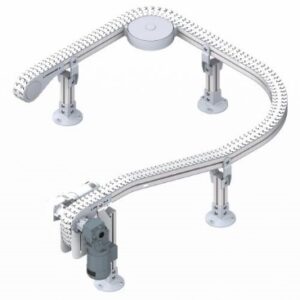Considerations for Choosing the Right Conveyors for Packaging Lines
By: Justin Quattlebaum, Product Manager for VarioFlow plus Conveyors

Today’s advanced plastic chain conveyors, such as Bosch Rexroth’s VarioFlow plus system, provide the modular flexibility and quiet, efficient transport today’s packaging lines require to maximize throughput and productivity.
It’s really no cliché to say that change is nearly the only constant in the packaging industry. Whether a packaging line is filling bottled water, liquid hand soap, battery packs or picnic plates, consumer packaged goods operations are constantly faced with the need to be agile and responsive to changing consumer trends, new product fads and innovative packaging concepts.
Coupled with the potential for unanticipated demand disruption, such as the massive spike in demand for household products during the COVID-19 pandemic, it’s clear that packaging operations must have production platforms that enable efficient changeovers and reconfigurations of packaging workflows, technology that minimizes downtime when changes are necessary.
One of the most critical components for an agile, modular packaging line is its transport technology. Today’s modular plastic chain conveyor systems incorporate design and technology features such as increased flexibility and more interchangeable conveyor modules. They also respond to several other key industry trends, such as larger and heavier packages, increased reliability and uptime through more reliable belts, chains and gearboxes and the ability to easily incorporate Industry 4.0 capabilities such as sensors into existing conveyor systems.
As the industry’s needs have changed and evolved, so too have the key features and capabilities of plastic chain conveyor systems. Choosing the right system is critical when implementing a new packaging line or upgrading existing facilities. Understanding what capabilities the latest generation of plastic chain offers can help packaging lines make the best choice for their current and future requirements.
Key role of conveyors in packaging operations

New materials and multiple plastic chain options like those offered by VarioFlow plus give packaging line operations options as they design solutions for their unique product and operational requirements.
At one time, conveying systems were seen as one of the last considerations as packaging lines were designed and equipped. It was relatively common to find that the design and layout of packaging lines focused on packaging machinery, and conveyors tended to be treated as simply tasked with moving products from station to station.
However, today’s generation of modular chain conveyor systems have demonstrated the central role and importance of a high-quality, high-performance transport system in efficient, well-organized packaging, assembly and material handling applications. Current chain conveyor systems function to sustain uptime and productivity and maximize the return on capital investment in the entire line.
One of the most valuable contributions that flexible chain conveyors make to packaging lines is their modularity: the ease with which different components can be combined into the perfect layout and flow for a given production operation, and then the equal ease with which they can be modified and reconfigured to respond to changing product needs as market and consumer tastes evolve.
Modularity and flexibility are two of the most important considerations to assess when choosing a chain conveyor system. In addition, modular chain conveyors can relieve bottlenecks and other product flow challenges via line buffering and accumulators. They can also support rapid changes in process speeds, infeed/outfeed demands, production disturbances and changeovers for product dimension changes or labeling updates.
Chain conveyors that are engineered to maximize modularity feature components that can be easily combined for custom layouts. These components can include the flexible chain, guide components, curves, motors and gearboxes. Variable configurations can accommodate different package sizes and shapes and different climbs and descent rates when moving product from one level to another on a line.
It’s also important to assess the qualities of the plastic chain itself. A stable chain that can handle high tensile forces (today’s leading chain conveyors support up to 1250 N) at high speed can save system cost by reducing the number of drives needed over a given length.
New features offer improved performance and value

Standardized modular components such as diverters, accumulators, stop units and curve units make it easy to adjust and reconfigure transport layouts based on constantly changing consumer preferences and packaging formats.
Leading chain conveyor manufacturers have continued to invest in their systems, incorporating advances in existing features as well as new capabilities to enable them to provide more versatile functionality and performance for packaging lines.
They have invested in improving core components of the conveyors to make all the components across different models highly interchangeable. With the introduction of common profile design, common slide rail design and a more uniform chain design, one leading conveyor system can now handle, under normal transport, up to 250 kilograms (kg) in a single line.
This is making it possible to provide packaging operations the ability to create much longer straight runs if they need to, based on their plant’s footprint and specific production requirements. However, with the introduction of gear motors with an IE3 efficiency rating, these longer runs remain energy efficient. The motors use the same amount of power that was previously used for shorter lengths; the newer motor-gearbox combinations can also be tuned to boost the power output so that heavier loads can be handled on the same conveyor.
These gear motors also offer an expanded range of throughput speeds — one conveyor provider supports throughput rates from three meters per minute up to 60 meters per minute for some very fast packaging applications, such as pill bottle filling or blister pack sealing.
There have also been advances in plastic chain design to accommodate a wider range of material weights and configurations and the way those materials need to be moved through packaging lines. In one example, a manufacturer needed to move lightweight metal and plastic product lids up multiple inclines. The conveyor manufacturer provided plastic chain with a flocked surface that provided just enough friction to hold the product in place as it moved upward without damaging the lids in any way.
Other improvements in plastic chain’s design and the materials used in it, combined with refinements in the slide rail design, have significantly improved the coefficient of friction for the entire system. This provides several key benefits: conveyor moving parts last much longer and require less frequent maintenance intervals, the overall system runs more quietly, and the reduced friction also contributes to improved overall energy efficiency.
Conveyors offer a simple yet creative platform to help packaging companies guide products through specialized motions at relatively high throughput speeds. For example, if a packager needs to change the orientation of a box or package, to flip it over, turn it around or otherwise change its position on the chain, companies will sometimes purchase complex handling machines to perform the task.
However, sometimes a conveyor system can incorporate a guide rail positioned at 90 degrees to the flow of product, at just the right angle, to change the orientation of the product; or, if the package needs to be flipped over, it can be dropped off a ledge from one conveyor to the next to accomplish the move. Using these methods depends on several factors, such as the product being conveyed, the shape and dimensions of the package, how stable it is terms of center of gravity, and how fragile the contents may be.
Integrating chain conveyors into Industry 4.0 operations

Leading conveyor manufacturers support their products with state-of-the-art digital design and configuration tools like Bosch Rexroth MTpro software, which enables product selection, configuration and ordering from a single tool.
Many leading packaging operations are making large-scale investments in Industry 4.0 technology and controls, seeking to capture, analyze and leverage real-time data about a host of automation operations to continuously fine-tune and improve their operations.
In many ways, chain conveyors can be viewed as the “backbone” of any successful implementation of I4.0 capabilities, since the conveyor transports the product from start to finish in the packaging flow. Companies are beginning to invest in “smart conveyors,” using sensors or RFID tags to precisely track the flow of every item through the system.
There have also been significant moves to replace pneumatic actuation of diverters and other positioning devices on some conveyor platforms with electric actuation, which can incorporate I/O sensor and control data that connect with automation PLCs for a complete picture of the conveyor’s operating conditions.
Conveyors are also being engineered to more easily integrate into electronic production floor Kanban systems so that the rest of the line and the plant knows how “the backbone” is operating. Combining this data with AI-based real-time analytics will enable packagers to rapidly find an issue on a line and resolve it with as little human intervention as possible, helping lower total cost of ownership and improve return on investment.
Working through the conveyor options
Modular plastic chain conveyors are high-performance, versatile components of any modern packaging line, offering the reliable operation and flexible configurability today’s packaging operations need to meet constantly changing marketplace and consumer preferences.
Whether a company is installing a new packaging line or is considering upgrading or significantly redesigning existing facilities, it makes sense to work with conveyor technology providers who supply expert engineering support and online design and configuration tools. There are also advantages to working with companies that supply conveyors across multiple global markets — particularly if the consumer product company has packaging lines in multiple locations.
By engaging with a conveyor expert early, they can understand the unique space and footprint conditions of the facility where the conveyor will be installed, as well as the packaging processes, throughput and quality control requirements at both a packaging machine and assembly station level, as well as how the whole line works as one system.
They can provide recommendations and special features that can help ensure that the line operates with the efficiency, throughput and reliability needed to meet all production goals.







